

04/2005
Every other year, representatives from the AIA and the American Library Association gather to celebrate the finest examples of library design by architects licensed in the U.S. The 2005 AIA/ALA Library Building Awards honor eight disparate projects, ranging in size from an architecture school library to the central facility for a major city. All share successful resolution of their patrons’ needs into harmonious and beautiful designs.
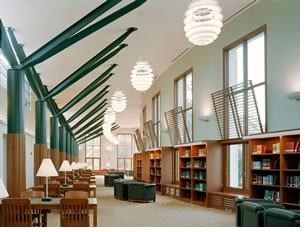 Arcadia University Landman Library, Glenside,
Pa., by R.M. Kliment & Frances
Halsband Architects, for Arcadia University
Arcadia University Landman Library, Glenside,
Pa., by R.M. Kliment & Frances
Halsband Architects, for Arcadia University
This design, in response to a competition for an addition to a university
library, placed a new wing at the south face of the existing library.
The resulting new, curved limestone building forms a distinctive presence
at the heart of the campus and accommodates 150,000 volumes; a multimedia
collection; the college’s archives; study seating for 300 in reading
rooms, carrels, and groups rooms; multimedia classrooms; and the trustees
room. The library strives to provide a variety of spaces and places for
reading and study, with controlled daylighting and campus views, including
a two-story-high reading room on the second floor that extends the full
width of the building and looks out over the campus green. The circulating
collection, housed on three floors in the older portion of the building,
is adjacent to the study areas and a small café.
Photo © Cervin Robinson.
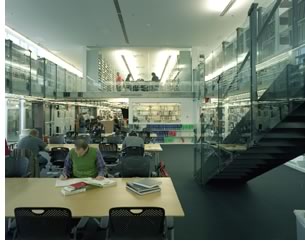 Austin E. Knowlton School of Architecture Library—The Ohio State University,
Columbus, Ohio, by Mack Scogin Merrill Elam Architects with associate
architect Wandel and Schnell Architects, for the Ohio State University
Austin E. Knowlton School of Architecture
Austin E. Knowlton School of Architecture Library—The Ohio State University,
Columbus, Ohio, by Mack Scogin Merrill Elam Architects with associate
architect Wandel and Schnell Architects, for the Ohio State University
Austin E. Knowlton School of Architecture
When considering this library as part of the program for their school
of architecture, the faculty wanted to create an information and knowledge
resource that also could serve as a reflective space away from the work
environment of the design studios. This two-story glass-box, book-lined “room” accommodates
30,000 volumes and seating for 70 people in 40 table seats and 30 lounge
chairs—each designed by a famous architect or designer. The library
has an ample circulation desk with a closed reserve area, staff offices,
workroom and storeroom, copy room, reference and journal areas, digital
library, and rare book room. With “reading rooms” at either
end—and library services in the middle—the staff interacts easily with
the users and maintains control of the space. Located at the end of the
building’s circulation system, overlooking a roof garden, the library
is both very visible and removed from the major action of the building.
As a small indication of the library’s success, it drew more than
20,000 visitors in its first three months of operation while serving
a population of 750.
Photo © Timothy Hursley.
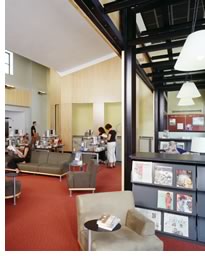 Carnegie
Library of Pittsburgh, Brookline, by Loysen + Kreuthmeier Architects,
for the Carnegie Library of Pittsburgh
Carnegie
Library of Pittsburgh, Brookline, by Loysen + Kreuthmeier Architects,
for the Carnegie Library of Pittsburgh
The architects were charged with turning a nondescript, two-story concrete
block with a zero lot line into a dynamic storefront library. The program
called for doubling the library’s space, which included expanding
the children’s department and adding an internet café, popular
library, and “self-help” stations. Daylighting the windowless
building proved the greatest design challenge, the architects say. A
new interior lining peels away from the rigid concrete shell and, with
the addition of a light wall, allows natural light from skylights and
clerestories to penetrate the spaces. To transform the low-ceiling basement
into a delightful children’s library, plaster ceilings tilt fancifully
to fit HVAC equipment. Although the library has doubled in size, the
new building, which has applied for LEED™ certification from the
U.S. Green Building Council, has a zero increase in energy consumption
over the old building.
Photo courtesy of the architect.
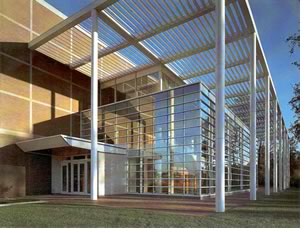 The Georgia Archives, Morrow, Ga., by Hellmuth, Obata + Kassabaum, for
the Development Authority of Clayton County
The Georgia Archives, Morrow, Ga., by Hellmuth, Obata + Kassabaum, for
the Development Authority of Clayton County
A highly specialized government entity, quartered in 17 stories of a
dark, monolithic building in Atlanta, asked the architects to create
a new building that would redefine the visibility of their mission to
the public. The architect’s first major intention was to design
around how the organization works. On a separate but parallel track,
the second major intention centered on designing for how visitors are
received and screened for security purposes and how they may enjoy the
education, research, and cultural opportunities presented. Operations
and public access are designed to be separate, meeting only at specific,
secure points. To supplement this technically rigorous program, the architects
sited the building to preserve existing stands of trees and the site’s
natural contours. Additionally important is the building’s pervasive
natural light, tempered with high-performance glass to eliminate UV penetration,
sunscreens, and porches.
Photo courtesy of the architect.
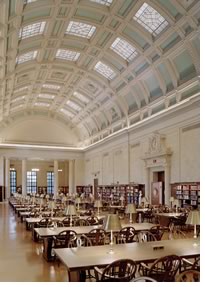 Harry Elkins Widener Memorial Library
Renovation, Cambridge, Mass., by Einhorn Yaffee Prescott Architecture & Engineering
PC, for Harvard University
Harry Elkins Widener Memorial Library
Renovation, Cambridge, Mass., by Einhorn Yaffee Prescott Architecture & Engineering
PC, for Harvard University
This 1915 library, designed by Horace Trumbauer, sits at the geographical
and intellectual heart of the university. In renewing the building for
the 21st century, the project called for a renovation that would “simultaneously
redefine the academic research library in programmatic and technical
terms without losing the aura, comfort, and connection to tradition.” The
first phase of the project entailed upgrading and modernizing the building
system infrastructure and the original 10-floor self-supporting stack
structure and library support spaces. New systems were threaded through
the stacks, and the architects “found” space within two large
light wells for new mechanical space, staff work areas, and two skylighted
reading rooms. The second phase involved restoration of the historic
public and reading spaces, in which existing features and room finishes
were preserved whenever possible.
Photo © Peter Aaron/ESTO Photographics.
 Issaquah Public Library, Issaquah, Wash., by Bohlin Cywinski Jackson,
for the King County Library System
Issaquah Public Library, Issaquah, Wash., by Bohlin Cywinski Jackson,
for the King County Library System
This new 15,000-square-foot library offers its hometown an expansion
and modernization of library services in a more prominent and centralized
location in the historic downtown core. The cedar-sided structure used
an exaggerated building height to meet both the library’s programming
needs of one level and the city code’s call for multifamily urban
structures. A trellis and canopies help maintain human scale at the street
level. On the corner of the site is a large covered area, or agora, that
serves as a sheltered gathering place and marks the entrance to the building.
Activity in the library’s multipurpose room, adjacent to the agora,
is visible to the street. Doors open to the outside for special events.
Entering the building from the agora, one passes through a wood-lined
lobby and under a pair of tilted columns into the main space. Additional
round columns taper slightly as they rise to meet the wood-lined ceiling.
Light filters in the clerestory windows to highlight a delicate metal
truss at the spine of the building.
Photo © Fred Housel.
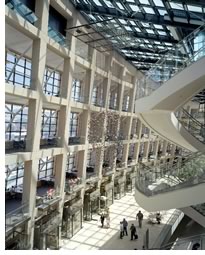 Salt Lake City Public Library, Salt Lake City, by VCBO Architecture
LLC, with design architect Moshe Safdie and Associates, for the Salt
Lake City Public Library
Salt Lake City Public Library, Salt Lake City, by VCBO Architecture
LLC, with design architect Moshe Safdie and Associates, for the Salt
Lake City Public Library
This 200,000-square-foot facility is part of an ambitious program by
the library to double its space for collections, establish a landmark
in the city’s civic core, and create a lively interactive public
space currently missing in the downtown area. The new library features
a triangular main building, adjacent rectangular administration building,
glass-enclosed “urban room,” and public piazza. Its reading
galleries, which replace the traditional formal reading room, accommodate
the “community of readers” in intimate spaces that are private
yet visually connected to magnificent exterior views. The library’s
sloped and curving wall has become an icon for the city, and the shops
and food establishments at its base weave the site together. The wall
also defines a connection to the city’s former library, which will
become an arts and science center. The library’s roof garden offers
spectacular views of the city and surrounding mountains. The library
also is a 2004 national AIA Honor Award for Architecture recipient.
Photo © Timothy Hursley.
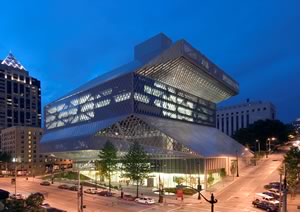 Seattle Central Library, Seattle, by a joint venture of OMA/LMN (Office
for Metropolitan Architecture and LMN Architects), for the Seattle Public
Library
Seattle Central Library, Seattle, by a joint venture of OMA/LMN (Office
for Metropolitan Architecture and LMN Architects), for the Seattle Public
Library
The design goal for this library was to redefine the library as an institution
no longer exclusively dedicated to the book, but as an information story
in which all forms of media—new and old—are presented equally
and legibly. Unlike traditional libraries, Seattle Central Library is
organized into spatial compartments that are dedicated to and equipped
for specific duties. Each platform is a programmatic cluster that is
architecturally defined and equipped for maximum performance. The spaces
between the platforms function as trading floors where librarians inform
and stimulate. The library’s unique “book spiral” addresses
the ongoing problem of subject classification. For example, in 1920 the
library had no classification for computer science, but by the early
1990s the section had exploded. Using the Dewey Decimal System, the architects
arranged the collection in a continuous ribbon—running from “000” to “999”—the
subjects form a coexistence that approaches the organic. Each evolves
relative to the others, occupying more or less space on the ribbon, but
never forcing a rupture. The library also garnered a 2005 national AIA
Honor Award for Architecture.
Photo © Pragnesh Parikh.
Copyright 2005 The American Institute of Architects.
All rights reserved. Home Page ![]()
![]()
 |
||
2005 AIA/ALA Library Building Awards Jury ALA: Anne Larsen Jonalyn Woolf-Ivory AIA: Sheila Kennedy, AIA Jeffrey Scherer, FAIA
|
||